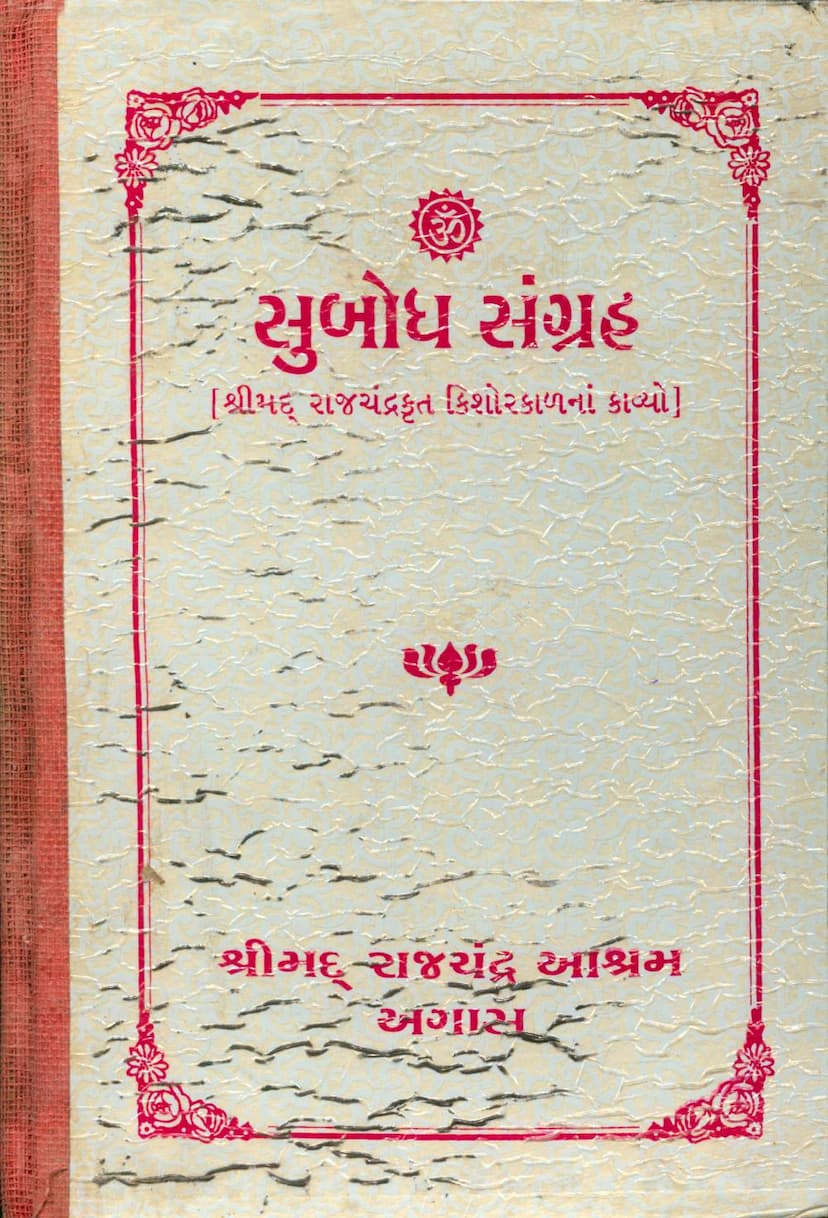Subodh Sangraha
Added to library: September 2, 2025

Summary
The book "Subodh Sangraha" (સુબોધ સંગ્રહ) is a collection of poems and writings by Shrimad Rajchandra, primarily from his youth. The title translates to "A Collection of Wise Teachings." This summary draws from the provided pages, focusing on the content and its presentation.
Overall Content and Purpose:
"Subodh Sangraha" compiles various poetic works and prose pieces penned by Shrimad Rajchandra during his formative years, from his childhood to his late teens. The collection serves as a testament to his prodigious talent, spiritual inclinations, and keen observations on life and society, even at a young age. The primary aim appears to be to preserve and share these early literary and philosophical insights, demonstrating the depth of his thought and his commitment to ethical and spiritual living.
Key Sections and Themes:
The book is meticulously organized, as evidenced by the detailed table of contents. Some of the prominent sections and their themes include:
- Poems Composed Spontaneously During Avadhan Performances: This section features short, quick poems created on the spot during Shrimad Rajchandra's renowned "Avadhan" (a mental feat of remembering and reciting various pieces of information). These poems, often based on seemingly trivial or abstract prompts, showcase his wit, poetic skill, and underlying spiritual focus. Examples include poems on "Dharma" (Religion), "Gulchchho" (Tassel), "Aakash-Pushpa" (Sky Flower), "Kankaro" (Pebble), "Rang Ni Pichkari" (Color Sprinkler), "Karm Ni Gati" (The Movement of Karma), "Muni Ne Pranam" (Salutations to a Sage), and "Ratri Khara Bapor" (Night at High Noon). The preface highlights that even when responding to prompts about inanimate objects, his verses often steer towards themes of renunciation and spiritual pursuit.
- Stri Niti Bodhak (Advice for Women): This substantial section, divided into four parts, offers comprehensive guidance on morality, education, and conduct for women. It emphasizes the importance of education for women, the dangers of ignorance, the need for righteous living, and adherence to principles like fidelity. It includes prayers, advice on virtues, and discussions on the transient nature of the body and the importance of diligent effort. The preface to this section stresses the significant impact of mothers on children and advocates for proper female education to uplift society. It also criticizes child marriage and its detrimental consequences.
- Devotional and Inspirational Poems: The collection includes devotional pieces like "Hanuman Stuti" (Praise of Hanuman), reflecting devotion and seeking divine aid.
- Social Commentary and Advice: Several poems address societal issues and offer advice to various groups, such as "Swaradeshiyon Ne Vinanti" (An Appeal to Compatriots), "Shrimant Janone Shikhaman" (Advice to the Wealthy), and "Hunnnar-Kala Vadhava Viche" (On Increasing Skills and Arts). These pieces highlight his concern for the progress and well-being of society and his nation.
- Avadhan Recitals and Problem-Solving Poems: Throughout the book, there are numerous instances of poems generated during "Avadhan" sessions, often responding to specific themes or "problems" presented. These showcase his remarkable intellectual agility and creative capacity under pressure. Examples include poems based on "Sagarnen Fien Kem Vare Chhe?" (Why do the Oceans Foam?), "Chopato" (A Game of Dice), "Tamaku Ni Dabli" (Tobacco Pouch), "Ishwar Lila" (God's Play), "Shal" (Shawl), "Ghadiyal Na Dunka" (Clock Ticks), "Diwan Khana" (Drawing Room), "Lavang" (Clove), "It" (Brick), "Naliyu" (Drain), "Pani" (Water), "Kalam" (Pen), "Chhabi-Hokani Tulna" (Comparison of Pictures and Hookahs), "Pavan Ni Riiti" (The Nature of Wind), "Aag Gad" (Train), "Daraiyo" (Ocean), "Kamal" (Lotus), "Prem Ni Kala Nyari Chhe" (The Art of Love is Unique), "Khabo Shrimant Kon?" (Who is the Truly Wealthy?), "Ghode Dahade Dhad" (Daylight Robbery), "Kajoda" (Unsuitable Marriages), and "Antarlipika" (Anagrams).
- Historical and Patriotic Poems: Pieces like "Veer Smaran" (Remembrance of Heroes) and "Arya Prajani Padati" (The Decline of the Aryan People) reflect a deep sense of history, national pride, and concern for the state of his homeland. The "Arya Prajani Padati" section, in particular, is a lengthy and detailed critique of the societal, cultural, and religious decline observed in India at the time, lamenting the loss of ancient virtues and practices.
- Prose Pieces: The book also includes some prose sections, such as advice to kings and reflections on various life principles.
Author's Early Life and Talent:
The preface highlights Shrimad Rajchandra's extraordinary intellect and spiritual awareness from a very young age. It mentions that his innate qualities were evident early on, with supernatural insights occurring as early as seven years old and poetic compositions written at eight that were recognized as mature later in life. His early engagement with spiritual practices like "Avadhan" at a young age further underscores his exceptional nature.
Publisher and Editions:
The book is published by Shrimad Rajchandra Ashram, Agas. The provided pages indicate a third edition published in 1997 (Vikram Samvat 2053), with a print run of 1500 copies.
In essence, "Subodh Sangraha" is a valuable compilation that offers a glimpse into the multifaceted genius of Shrimad Rajchandra during his youth. It showcases his poetic prowess, his deep spiritual insights, his social consciousness, and his early efforts to impart wisdom and guidance through his writings.